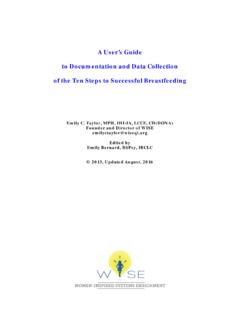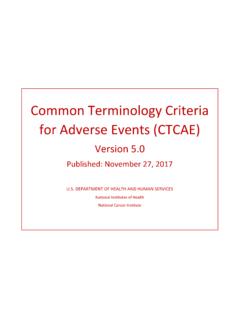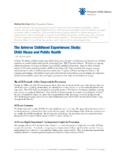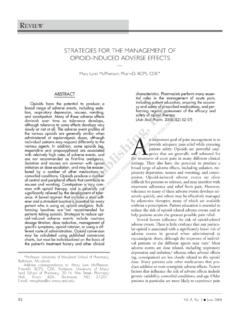Transcription of for Measuring Adverse Events - IHI
1 IHI Global Trigger Toolfor Measuring Adverse EventsSecond Edition13 Innovation Series 2009 Copyright 2009 Institute for Healthcare ImprovementAll rights reserved. Individuals may photocopy these materials for educational, not-for-profit uses, provided that the contents are not altered in any way and that proper attribution is given to IHI as the source of the content. These materials may not be reproduced for commercial, for-profit use in any form or by any means, or republished under any circumstances, without the written permission of the Institute for Healthcare name Global Trigger Tool is a common law trademark of the Institute for Healthcare to cite this paper:Griffin FA, Resar RK. IHI Global Trigger Tool for Measuring Adverse Events (Second Edition). IHII nnovation Series white paper. Cambridge, Massachusetts: Institute for Healthcare Improvement; 2009.(Available on )Acknowledgements:The Institute for Healthcare Improvement (IHI) would like to thank the following individuals for their contributions to the work:David Classen, MD, MS, Senior Partner and Chief Medical Officer, Computer Sciences Corporation Frank A.
2 Federico, RPh, Executive Director, Strategic Partners, IHIC arol Haraden, PhD, Vice President, IHIT erri Simmonds, RN, IHI FacultyJohn Whittington, MD, IHI Senior FacultyLee Adler, DO, Vice President, Safety and Quality Innovation and Research, FloridaHospitals/Adventist Health SystemsNancy L. Kimmel, RPh, SSBB, Missouri Baptist Medical CenterMargie McKeever, RN, BS, Project Manager, Florida HospitalIHI also thanks staff members Jane Roessner, PhD, and Val Weber for their editorial review and assistance with this reprint requests, please contact:Institute for Healthcare Improvement, 20 University Road, 7th Floor, Cambridge, MA 02138 Telephone (617) 301-4800, or visit our website at Institute for Healthcare Improvement (IHI) is a not-for-profit organization leading theimprovement of health care throughout the world. IHI helps accelerate change by cultivatingpromising concepts for improving patient care and turning those ideas into action.
3 Thousands of health care providers participate in IHI s groundbreaking have developed IHI's Innovation Series white papers as one means for advancing our ideas and findings in these white papers represent innovative work by IHI and organizationswith whom we collaborate. Our white papers are designed to share the problems IHI is working to address, the ideas we are developing and testing to help organizations make breakthroughimprovements, and early results where they exist. IHI Global Trigger Toolfor Measuring Adverse EventsSecond EditionInnovation Series 2009 Authors:Frances A. Griffin, RRT, MPA:Director, IHIR oger K. Resar, MD:Senior Fellow, IHII nnovation Series: IHI Global Trigger Tool for Measuring Adverse Events (Second Edition)1 Executive SummaryTraditional efforts to detect Adverse Events have focused on voluntary reporting and tracking of errors. However, public health researchers have established that only 10 to 20 percent of errorsare ever reported and, of those, 90 to 95 percent cause no harm to patients.
4 Hospitals need a moreeffective way to identify Events that do cause harm to patients in order to quantify the degree andseverity of harm, and to select and test changes to reduce harm. The IHI Global Trigger Tool for Measuring Adverse Events provides an easy-to-use method foraccurately identifying Adverse Events (harm) and Measuring the rate of Adverse Events over Adverse Events over time is a useful way to tell if changes being made are improving thesafety of the care processes. The Trigger Tool methodology is a retrospective review of a randomsample of inpatient hospital records using triggers (or clues) to identify possible Adverse hospitals have used this tool to identify Adverse Events , to assess the level of harm from each Adverse event, and to determine whether Adverse Events are reduced over time as a result of improvement efforts. It is important to note, however, that the IHI Global Trigger Tool is notmeant to identify every single Adverse event in an inpatient record.
5 The methodology, recommendedtime limit for review, and random selection of records are designed to produce a sampling approachthat is sufficient to determine harm rates and observe improvement over time. The Institute for Healthcare Improvement (IHI) formed the Idealized Design of the MedicationSystem (IDMS) Group in May 2000. This group of 30 physicians, pharmacists, nurses, statisticians,and other professionals established an aim to design a medication system that is safer by a factor of10 and more cost effective than systems currently in use. The Trigger Tool for Measuring AdverseDrug Events was initially developed by this group to assess progress on this safety goal and providedthe basis for development of subsequent Trigger white paper is designed to provide comprehensive information on the development andmethodology of the IHI Global Trigger Tool, with step-by-step instructions for using the tool to measure Adverse Events in a hospital.
6 2009 Institute for Healthcare Improvement2 Institute for Healthcare Improvement Cambridge, MassachusettsForeword to Second EditionSince its development in late 2003, use of the IHI Global Trigger Tool has spread from collaborativeprojects to large-scale improvement efforts, including IHI s 5 Million Lives Campaign. The IHIG lobal Trigger Tool has become a tool that hundreds of hospitals in multiple countries now use tomonitor Adverse event rates while working to improve patient safety. In 2008, the US Departmentof Health and Human Services Office of Inspector General completed a pilot study to measureadverse Events in Medicare beneficiaries and used the IHI Global Trigger Tool as one method extensive use of the IHI Global Trigger Tool has provided the opportunity to collectfeedback from those using the tool and identify opportunities to clarify definitions and Second Edition of the IHI Global Trigger Tool for Measuring Adverse Eventswhite paper contains no substantive changes to the overall methodology or process for review.
7 Clarifications have been made to some text and trigger definitions. References have been added based on recentpublications related to Trigger Tools. Experienced reviewers will note that there are changes to thelist of triggers. A number of triggers have been removed, particularly in the Surgical module, asthese triggers were found over time to not be very useful. The development of a Perinatal TriggerTool provided the opportunity to update the Perinatal module with additional triggers that will be useful to identify possible Adverse Events . Changes to the triggers in the Second Edition will not affect data for organizations that have beenusing the prior version of the IHI Global Trigger Tool because triggers are not measured; onlyadverse Events are measured. Organizations with months or years of Adverse event data from IHIG lobal Trigger Tool reviews can continue to conduct reviews using the modified trigger list andincorporate the results into the same data set.
8 The triggers listed in the IHI Global Trigger Tool are recommendations only and organizations are encouraged to modify them as needed. 2009 Institute for Healthcare ImprovementInnovation Series: IHI Global Trigger Tool for Measuring Adverse Events (Second Edition)3 2009 Institute for Healthcare ImprovementTable of ..4A. HistoryB. Harm versus ErrorC. Definition of an Adverse EventD. Commission versus OmissionE. PreventabilityF. Severity RatingsG. Trigger and Methods ..7A. Review TeamB. Sampling Patient RecordsC. Review ProcessD. Determination of an Adverse EventE. Data and Definitions ..15A. Cares Module TriggersB. Medication Module TriggersC. Surgical Module TriggersD. Intensive Care Module TriggersE. Perinatal Module TriggersF. Emergency Department Module ..23A. General ConsiderationsB. Read the IHI Global Trigger Tool White PaperC. Phase 1: Training RecordsD.
9 Phase 2: Practice for from Experienced Organizations ..26A. Florida HospitalB. Mayo ClinicC. OSF Healthcare SystemD. Tayside Healthcare System (Scotland)E. Missouri Baptist Medical CenterVII. Frequently Asked Questions ..29 VIII. Conclusion ..35A. ReferencesB. IHI Global Trigger Tool WorksheetC. IHI Global Trigger Tool Review Summary SheetD. Answers to Training Records for IHI Global Trigger Tool4 Institute for Healthcare Improvement Cambridge, Massachusetts 2009 Institute for Healthcare ImprovementI. BackgroundA. HistoryConventional attempts to quantify Adverse Events have included voluntary incident reports,retrospective or concurrent record reviews (sometimes supplemented by bedside surveillance),and abstraction of Events from observational databases. The concept of a trigger (or clue)to identify Adverse Events in the medical record was introduced by Jick in and automated the approach by using electronic triggers with an integrated hospitalinformation system to identify patient records and review the same records for use of triggers with manual record reviews was initially developed by theInstitute for Healthcare Improvement (IHI) in 1999 to identify only Adverse medicationevents; adaptation of the methodology for other areas of the hospital, such as intensive care, followed.
10 Recent publications describe the use and development of Trigger , IHI developed the IHI Global Trigger Tool for Measuring Adverse Events toidentify Adverse Events in adult inpatients, with some exclusions, throughout the Harm versus ErrorThe overall goal of improved safety in health care is to reduce patient injury or harm, whichunderscores the importance of distinguishing between errors and harm. Although detectionand analysis of errors is important in understanding failure-prone aspects of health caredelivery systems and designing strategies to prevent and mitigate these failures, there is special value in quantifying actual harm. Medical errors are failures in processes of care and,while they have the potential to be harmful, numerous reports have shown they are oftennot linked to the injury of the Events of harm are clear clinical outcomes,they are particularly likely to engage both clinicians and administrators in a thoroughreview of the system factors that led to the Adverse event, with a clear focus on improvingpatient outcomes.















